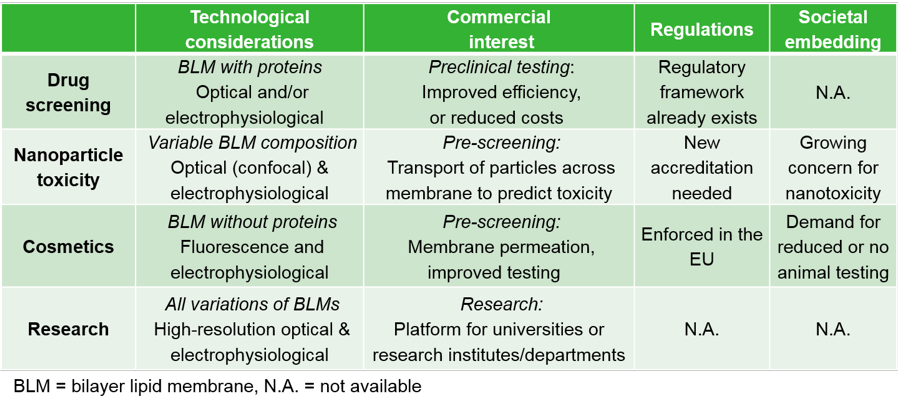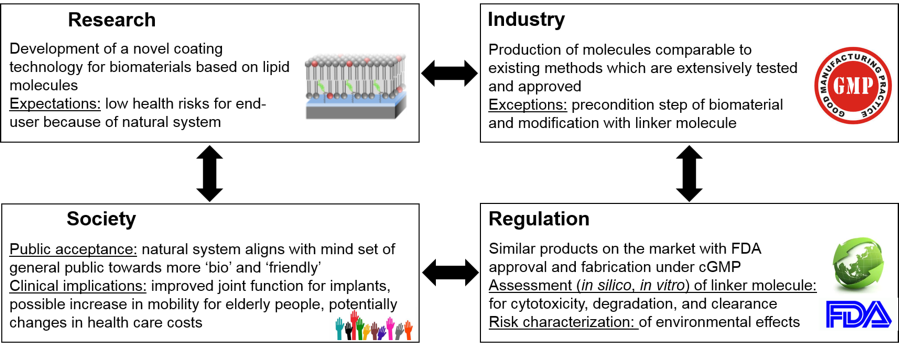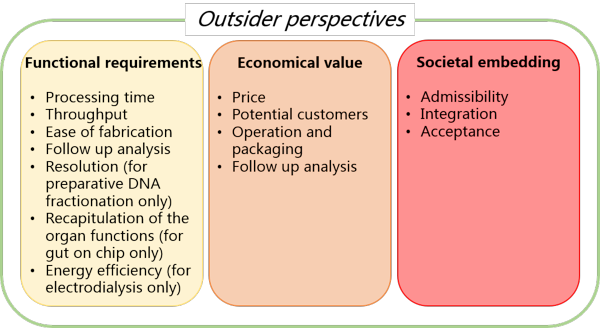Aim
The innovation value chain captures various dimensions that can influence technological development such as the research itself, economic aspects, regulations, and societal embedding. The innovation value chain shown below displays these dimensions, as well as linkages and feedback loops between them. In reality, innovation processes are highly complex and neither smooth nor linear: the various steps within an innovation process occur not sequentially but influence each other (Kline & Rosenberg, 1986; Deuten, 1997). For example, science not only leads to innovation but new innovations can also require new research. The innovation value chain model provides a starting point to think about chances and challenges in the innovation process.

Practical considerations and implementation
Characteristics | Practical Implementation |
|---|---|
Suggested time Short (hours/days) Level of difficulty Straightforward Materials Pen/Paper People involved Researcher (you) |
|
Examples
Comparing four nanomedicine applications
A PhD student used the dimensions of the innovation value chain to evaluate four applications for the microfluidic bilayer platform she developed during her project, as displayed in the table: drug screening, testing of nanoparticle toxicity, cosmetic screening and using the platform for research. The four application areas were selected from a multi-path map that she created with other participants during a workshop. When comparing the applications, it becomes clear that the innovation processes are different. In the case of drug screening, the technology must fit in the existing procedures and requirements that are present in pharmaceutical companies. Additionally, the technology must adapt to the regulatory framework. A direct impact on society is not envisioned for this application. In contrast, research can be driven by a demand in the society to reduce animal testing, as in the case of cosmetic screening, which leads to a requirement for new technologies that replace animal models. Here, the platform developed by the PhD student potentially could play a role. Research could also be triggered by new regulations for testing nanoparticle toxicity. In this case, the growing concern about nanotoxicity stimulates new accreditation procedures and therefore also new platforms that can contribute to determine the toxicity or safety of nanoparticles. A detailed discussion of the dimensions can be found in the thesis of the PhD student (Stimberg, 2014).

Innovation value chain for a lipid-based coating
Similarly, one envisioned application in a research project can be tested by looking at the different dimensions of the innovation value chain. In the case of another PhD project, a novel lipid-based coating has been evaluated. The coating consists of biological material and therefore no health risks are expected. Also the production of the molecules is comparable to existing methods which are already certified. However, it becomes clear that further evaluation and safety assessment of the linker molecule, which has not been tested yet, is necessary for commercialization of this technology as required by existing regulations. The novel biomaterial could be applied in clinical products such as implants where it could improve their functionality and therefore reduce the amount of surgery needed for revisions. More detailed information about the technology and this discussion can be found in the thesis of the PhD student (van Weerd, 2015).

Innovation journeys for a lab-on-chip device
In this example, a lab-on-chip device with hydrogel pattern is developed, and different applications are envisioned: (1) DNA fractionation, (2) organ-on-chip, and (3) desalination. To analyze possible challenges and opportunities, each application is discussed in terms of different dimensions of the value chain. Here, the dimensions are slightly adapted into functional requirements, economical value and societal embedding. An overview of the dimensions for all applications can be found in the PhD thesis of the student (Gümüscü, 2016).

Literature
- Kline, S.J. and N. Rosenberg, 1986, An Overview of Innovation, in The Positive Sum Strategy: Harnessing Technology for Economic Growth, R. Landau and N. Rosenberg, Editors. National Academy Press: Washington D.C. p. 275-305.
- Deuten, J.J., A. Rip, and J. Jelsma, 1997, Societal embedding and product creation management. Technology Analysis & Strategic Management, 9(2): p. 131-148.
- Stimberg, V., 2014, Microfluidic Platform for Bilayer Experimentation - From a Research Tool towards Drug Screening. PhD thesis, University of Twente: Enschede.
- van Weerd, J., 2015, Novel biomedical applications of supported lipid bilayers. PhD thesis, University of Twente: Enschede, The Netherlands.
- Gümüscü, B., 2016, Lab-on-a-chip devices with patterned hydrogels. Engineered microarrays for biomolecule fractionation, organ-on-chip and desalination. PhD thesis, University of Twente: Enschede, The Netherlands.
